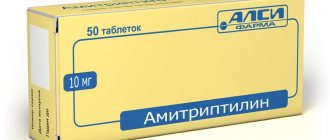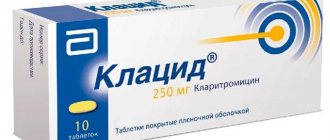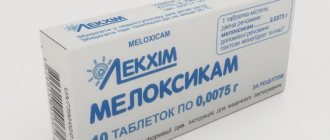pharmachologic effect
Alpha1-adrenergic blocker, quinazoline derivative. Selectively acts on postsynaptic α1-adrenergic receptors. In vitro studies have shown the selectivity of alfuzosin on α1-adrenergic receptors located in the prostate gland, in the bottom of the bladder and in the prostatic urethra.
As a result of a direct effect on the smooth muscles of the prostate tissue, it reduces resistance to urine outflow.
Alfuzosin improves urinary parameters by reducing urethral tone and bladder outflow resistance, and facilitates bladder emptying.
Directions for use and doses
The drug is taken orally after meals.
When treating functional symptoms of benign prostatic hyperplasia, the recommended dose is 1 tablet. (10 mg) 1 time/day.
As an adjuvant when using a catheter for acute urinary retention associated with benign prostatic hyperplasia, the recommended dose is 1 tablet. (10 mg) 1 time/day, starting from the first day of catheterization. The drug is used for 3-4 days, i.e. 2-3 days while using the catheter and 1 day after its removal.
The tablets should be taken whole.
Instructions:
Clinical and pharmacological group
28.003 (Drug used for urinary disorders associated with benign prostatic hyperplasia. Alpha1-blocker)
Release form, composition and packaging
Extended-release tablets are round, biconvex, three-layer (one white layer between two yellow layers with different color intensities); inclusions are allowed.
| 1 tab. | |
| alfuzosin hydrochloride | 10 mg |
Composition of the first layer of the tablet: hypromellose, hydrogenated castor oil, ethylcellulose 20, yellow iron oxide dye (E172), colloidal silicon dioxide aqueous, magnesium stearate.
Composition of the second layer of the tablet: alfuzosin hydrochloride, mannitol, hypromellose, microcrystalline cellulose, povidone, colloidal silicon dioxide aqueous, magnesium stearate.
Composition of the third layer of the tablet: hypromellose, hydrogenated castor oil, povidone, yellow iron oxide dye (E172), colloidal silicon dioxide aqueous, magnesium stearate.
10 pieces. - blisters (1) - cardboard packs. 10 pcs. - blisters (3) - cardboard packs.
pharmachologic effect
Alpha1-adrenergic blocker, quinazoline derivative. Selectively acts on postsynaptic α1-adrenergic receptors. In vitro studies have shown the selectivity of alfuzosin on α1-adrenergic receptors located in the prostate gland, in the bottom of the bladder and in the prostatic urethra.
As a result of a direct effect on the smooth muscles of the prostate tissue, it reduces resistance to urine outflow.
Alfuzosin improves urinary parameters by reducing urethral tone and bladder outflow resistance, and facilitates bladder emptying.
Placebo-controlled studies of alfuzosin in patients with benign prostatic hyperplasia showed a significant increase in maximum urinary flow rate (Qmax) of an average of 30% in patients with Qmax ≤15 ml/s. This improvement was noted after taking the first dose of the drug. There was also a significant decrease in resistance to urinary flow and an increase in the volume of urine excreted; There was a significant decrease in residual urine volume.
Pharmacokinetics
Suction and distribution
When taking the drug Dalfaz® SR, due to the characteristics of the dosage form, which provides prolonged release of alfuzosin hydrochloride, in healthy middle-aged volunteers, the average bioavailability is 104.4% compared to the immediate release form (when taken 2.5 mg 2 times a day).
Cmax is achieved 9 hours after dosing compared to 1 hour for the immediate release form. Plasma protein binding is about 90%.
Metabolism and excretion
Alfuzosin undergoes significant metabolism in the liver, only 11% of the dose taken is excreted unchanged in the urine; most of the inactive metabolites (75-90%) are found in the feces.
T1/2 is 9.1 hours.
Pharmacokinetics in special clinical situations
In elderly patients, pharmacokinetic parameters (Cmax and AUC) do not increase.
In patients with renal failure, Cmax and AUC are moderately increased (which has no clinical significance and does not require a change in the dosage regimen), T1/2 does not change.
The pharmacokinetic profile of the drug does not change in patients with chronic heart failure.
Dosage
The drug is taken orally after meals.
When treating functional symptoms of benign prostatic hyperplasia, the recommended dose is 1 tablet. (10 mg) 1 time/day.
As an adjuvant when using a catheter for acute urinary retention associated with benign prostatic hyperplasia, the recommended dose is 1 tablet. (10 mg) 1 time/day, starting from the first day of catheterization. The drug is used for 3-4 days, i.e. 2-3 days while using the catheter and 1 day after its removal.
The tablets should be taken whole.
Overdose
Symptoms: arterial hypotension.
Treatment: hospitalization is indicated, the patient should be in a supine position. Arterial hypotension is treated (administration of vasoconstrictors, solutions and high-molecular substances; measures aimed at increasing blood volume). Dialysis is ineffective due to the high degree of binding of alfuzosin to plasma proteins.
Drug interactions
Not recommended combinations
With α1-adrenergic receptor blockers (prazosin, urapidil, minoxidil): increased hypotensive effect, risk of severe postural hypotension.
Combinations to Consider
With antihypertensive drugs: increased hypotensive effect and risk of postural hypotension (additive effect).
With inhibitors of the CYP3A4 system (ketoconazole, itraconazole, ritonavir): increased concentrations of alfuzosin in the blood.
Side effects
From the digestive system: nausea, epigastric pain, diarrhea, dry mouth.
From the side of the central nervous system: headache, dizziness, weakness, drowsiness, asthenic syndrome, fainting, syncope.
From the cardiovascular system: tachycardia, orthostatic hypotension, in patients with coronary artery disease - exacerbation of angina symptoms.
Allergic reactions: rarely - skin rash, itching.
Other: swelling, skin hyperemia.
Storage conditions and periods
The drug should be stored out of the reach of children at a temperature not exceeding 25°C. Shelf life: 3 years.
Indications
- treatment of functional symptoms of benign prostatic hyperplasia;
- as an adjuvant when using a catheter for acute urinary retention associated with benign prostatic hyperplasia.
Contraindications
- orthostatic hypotension;
- severe liver dysfunction;
— severe renal failure (creatinine clearance <30 ml/min);
— intestinal obstruction (due to the content of castor oil in the preparation);
- hypersensitivity to alfuzosin and/or other components of the drug.
special instructions
In some cases, especially in patients receiving antihypertensive therapy, postural hypotension with or without symptoms (dizziness, fatigue, increased sweating) may develop within a few hours after taking the drug (as with other α1-adrenergic receptor blockers). In such situations, the patient should lie down until the symptoms disappear completely. These reactions are usually temporary, occur at the beginning of treatment and usually do not affect the continuation of therapy. The patient should be warned about the possibility of such reactions.
Patients with coronary insufficiency should not be prescribed Dalfaz® SR as monotherapy. It is necessary to continue treatment of coronary insufficiency. If angina attacks persist or their course worsens, the drug should be discontinued.
Patients should be warned that the tablets should be swallowed whole. Violation of the integrity of the tablet can lead to inappropriate release and absorption of the active substance and, accordingly, to adverse reactions that can quickly develop.
Impact on the ability to drive vehicles and operate machinery
Side effects such as dizziness, blurred vision and asthenia may occur mainly at the beginning of treatment. This should be taken into account when driving vehicles and operating machines.
Use for renal impairment
In patients with renal failure, Cmax and AUC are moderately increased, without a noticeable increase in T1/2 (these changes are not clinically significant and do not require a change in dosage regimen).
The drug is contraindicated in severe renal failure (creatinine clearance <30 ml/min).
Use for liver dysfunction
Contraindicated in cases of severe liver dysfunction.
Conditions for dispensing from pharmacies
The drug is available with a prescription.
special instructions
In some cases, especially in patients receiving antihypertensive therapy, postural hypotension with or without symptoms (dizziness, fatigue, increased sweating) may develop within a few hours after taking the drug (as with other α1-adrenergic receptor blockers). In such situations, the patient should lie down until the symptoms disappear completely. These reactions are usually temporary, occur at the beginning of treatment and usually do not affect the continuation of therapy. The patient should be warned about the possibility of such reactions.
Patients with coronary insufficiency should not be prescribed Dalfaz® SR as monotherapy. It is necessary to continue treatment of coronary insufficiency. If angina attacks persist or their course worsens, the drug should be discontinued.
Patients should be warned that the tablets should be swallowed whole. Violation of the integrity of the tablet can lead to inappropriate release and absorption of the active substance and, accordingly, to adverse reactions that can quickly develop.
Side effects such as dizziness, blurred vision and asthenia may occur mainly at the beginning of treatment. This should be taken into account when driving vehicles and operating machines.
Dalfaz
Active substance:
Alfuzosin*
Pharmgroup:
Alpha blockers
Average price in pharmacies
| Name | Manufacturer | average price |
| Dalfaz retard 0.005 n56 tablet prolong p/o | SANOFI RUSSIA | 1701.00 |
| Dalfaz sr 0.01 n30 tablet prolong | SANOFI RUSSIA | 1844.00 |
Analogs for the active substance:Alfuzosin Alfuzosin Alfuzosin hydrochloride Dalfaz retard Dalfaz SR | Application area:Prostate adenoma BPH Prostatic hypertrophy Prostate hypertrophy BPH Dysuric disorders caused by benign prostatic hyperplasia Dysuric disorder in benign prostatic hyperplasia Dysuria with prostate adenoma Benign prostatic hyperpalasia Benign prostatic hyperplasia Benign prostatic hyperplasia stages 1 and 2 Benign prostatic hyperplasia stages 1 and 2 in combination with prostatitis Benign prostatic hyperplasia grade I Benign prostatic hyperplasia grade II Benign prostatic hypertrophy Prostate disease Acute urinary retention associated with benign prostatic hyperplasia Paradoxical ischuria |




